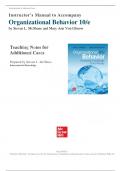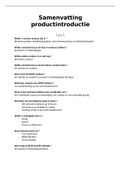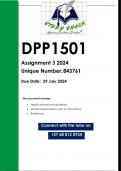Prüfung
Instructor’s Manual to Accompany Organizational Behavior 10th Edition by Steven L. McShane and Mary Ann Von Glinow
Kurs
Instructor’s Manual to Accompany Organizational..
Hochschule
Instructor’s Manual To Accompany Organizational..
Instructor’s Manual to Accompany Organizational Behavior 10th Edition by Steven L. McShane and Mary Ann Von Glinow
[ Mehr anzeigen ]
vorschau 4 aus 652 Seiten
Hochgeladen auf
19. april 2024
Anzahl der Seiten
652
geschrieben in
2023/2024
Typ
Prüfung
Enthält
Fragen & Antworten
Hochschule
Instructor’s Manual to Accompany Organizational..
Kurs
Instructor’s Manual to Accompany Organizational..
17,68 €
100% Zufriedenheitsgarantie
Sofort verfügbar nach Zahlung
Sowohl online als auch als PDF
Du bist an nichts gebunden
Teaching Notes for Additional Cases Page EOTC -1 © McGraw Hill LLC. All rights reserved. No reproduction or distribution without the prior written consent of McGraw Hill LLC. Instructor’s Manual to Accompany Organizational Behavior 10/e by Steven L. McShane and Mary Ann Von Glinow Teaching Notes for Additional Cases Prepared by Steven L. McShane Interconnected Knowledge NURSEDOCS Teaching Notes for Additional Cases Page EOTC -2 © McGraw Hill LLC. All rights reserved. No reproduction or distribution without the prior written consent of McGraw Hill LLC. E O T C Teaching Notes for Additional Cases INTRODUCTION TO TEACHING NOTES FOR ADDITIONAL CASES This document includes teaching notes for the additional cases in Organizational Behavior, Tenth Edition . Each case analysis includes a list of the most relevant case topics, a brief case synopsis, and a case analysis. The Additional Cases do not have any discussion questions. This gives instructors more flexibility to use these cases for assignments or in-class discussion. However, many of the teaching notes include case questions with suggested answers. Alternatively, some teaching notes present a suggested analysis of the case in terms of symptoms, problems, and recommendations. The next page provides a matrix of topics related to the additional cases in this book. The primary topics—







